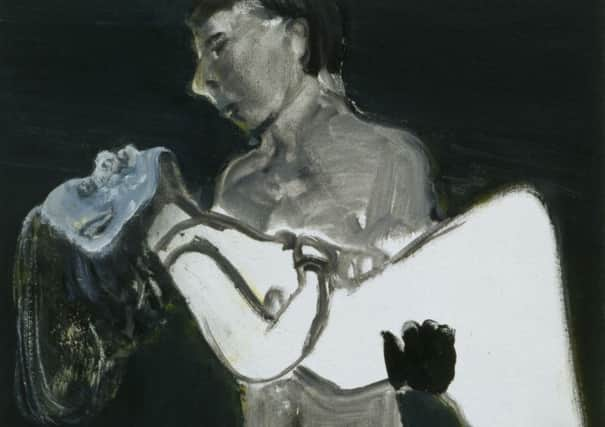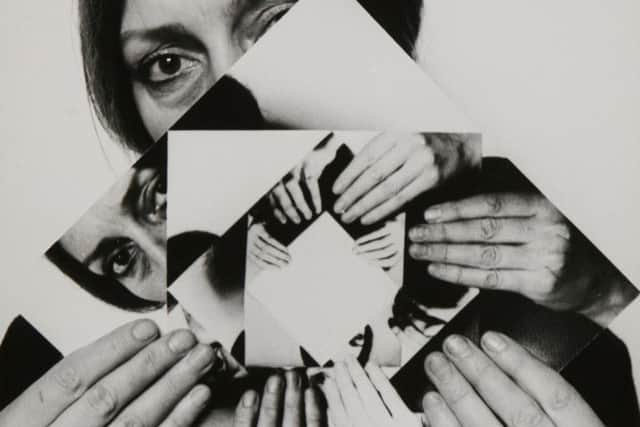Art reviews: Marlene Dumas – The Image As Burden


Marlene Dumas: The Image as Burden
Tate Modern, London ****
The Adventures Of The Black Square


Whitechapel Gallery, London ***
A small girl scowls stares reproachfully under a furrowed brow. Her eyes are dark, heavily lidded. Her naked stomach is splashed up to her collarbone with blue. One hand is wrist deep in black paint, the other scarlet.
When the South African-born artist Marlene Dumas took a photo of her daughter playing with paint in the garden and later made her own painting from the image, a moment of private abandonment was turned into something else.
Advertisement
Hide AdThe child is a tiny criminal, caught in the act. She is messy, unbridled: all the things a girl should not be. She is a malevolent spirit. Scary as she seems you can’t help siding with her. The artist sides with her too. The 1994 work, which is a central image in Dumas’ current marvellous retrospective at Tate Modern, is entitled The Painter and you sense it is a portrait of the artist herself as much as her daughter.
Dumas was once a small girl who played outside and loved to draw. She grew up on a farm on the outskirts of Cape Town, born in 1953, five years after the National Party began constructing the thicket of laws and regulations that created apartheid. She moved to Amsterdam in her early twenties, to study, and stayed on.
Now 61 and one of the most significant contemporary painters, long overdue a decent show for British audiences, she also holds the record for the most valuable work by a woman. A 2005 painting, entitled Victor, sold for £3.1 million. One imagines the artist herself has little time for such definitions as “most expensive woman artist”. Once, when asked what it was like to be a woman who painted, she wrote mischievously: “If painting is female and insanity is a female malady, then all women painters are mad and all male painters are women.”
The truth is that Dumas took on the big boys’ game and has made it her own. At a time when painting of the figure was all but exhausted she invested it with strangeness and power. She paints from photographs, but transforms her sources, with a hand that is both spare and expressive. “I deal with second-hand images, but first-hand experiences,” she has said.
The Tate show opens with a wall of ink and graphite drawings of faces made over a period of some 20 years. They are sloppy and wet looking, the faces blur and bleed. Sometimes the paper is torn, the eyes plucked out and replaced with a ragged under-painting. The work as a whole is entitled Rejects: each an image of our own imperfection and perhaps of the folly of the whole enterprise.
Here are children, awkwardly naked, an affront. Here is a wall of famous gay men, like Alan Turing, in a work that seems to have been designed specifically to get up the noses of the Russian authorities when the artist showed in St Petersburg last year. Dumas paints pain audaciously. Grieving mothers, lost children, the dead features of now-dead terrorists. When Patrice Lumumba’s widow Pauline grieved for her assassinated husband in 1961, she tore off her clothes, symbolically removing the vestments of worldliness and the strictures of the colonial powers that destroyed him. Who other than Dumas could make this a subject for paint?
Advertisement
Hide AdThe artist sometimes overreaches: it is hard to love her awkward painting of Princess Diana as a martyred saint in sugar-pink satin. But she also demonstrates that painting is not so highfalutin’ that it is immune to silliness, the foolishness and the worries of the world. Yet it is largely pain and death and politics that seep into the texture of her canvases. They are like stains that cannot be erased.
Across the city at the Whitechapel Gallery is a show that celebrates the artists who thought their work should not just record the world but change it. A crowded, incredibly lively though at times confusing show begins with a moment of intense focus. A tiny fierce little work, Black Quadrilateral is what is says, a black square floating on a background of white. It was painted in 1915 by Kazimir Malevich. These days the black is fading and the white darkening: it is grey and cracked like an old tile. But this is a work that changed everything.
Advertisement
Hide AdWhat came after comes in a rush and a squeeze as the show attempts to draw a new, century-long history of abstraction not as an escape from content but a rage against social restraint. It ranges from the photography of Russian Constructivism as a hymn to the machine age, to the deadpan emptiness of post-war American Minimalism, like Carl Andre’s lead floor tiles which are so self-effacing you can walk all over them. There is Mondrian, the geometric furniture of De Stijl, right up to Jenny Holzer’s 2010 image of a government record obscured by black rectangles where it has been redacted.
In a comic interlude, the US artist Andrea Fraser’s 1991 film May I Help You? writes a script for a female gallery guide to “explain” the black, abstract works of artist Allan McCollum. She veers from conventional flannel to brutal confessional. Like this exhibition as whole, the lasting meaning of all that emptiness is not always clear, but how we choose to navigate the past tells us a lot about our present.
• Marlene Dumas until 10 May; The Adventures of the Black Square until 6 April